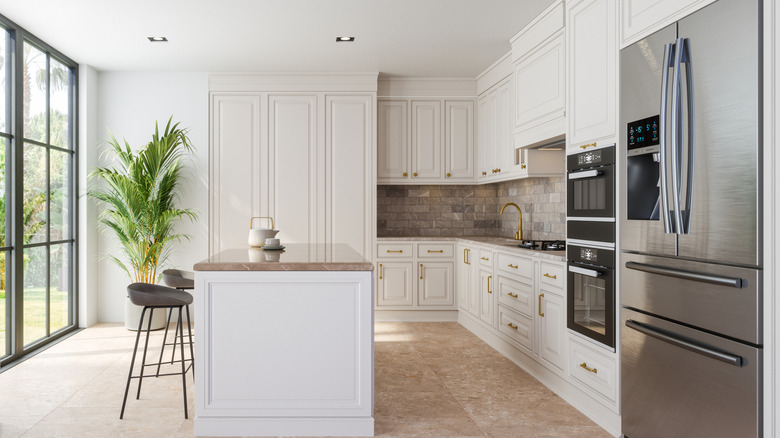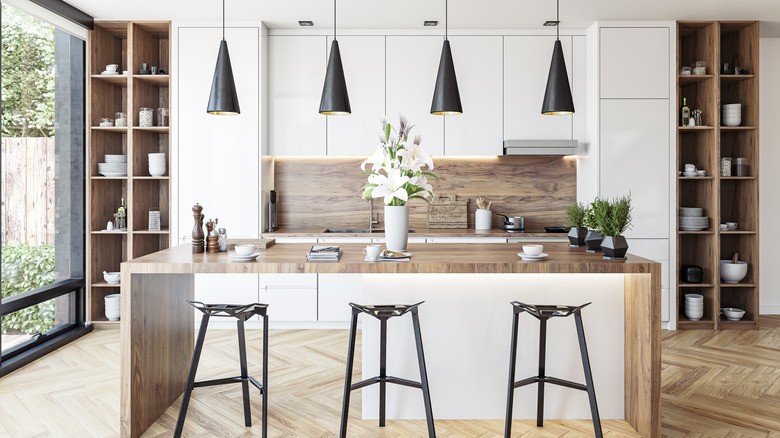How This Patterned Floor Is Kicking Basic Hardwood Out Of Kitchens
When designing a dream kitchen, flooring often gets overlooked. It's easy for it to be overshadowed by debates over whether quartz or granite makes the better countertop, or by discussions about which backsplash styles are already outdated. But choosing the right kitchen floor involves just as many considerations, and making sure you use the correct material and decide on a stylish, well-integrated pattern is just as essential when it comes to curating a cohesive kitchen aesthetic. One particularly fashionable flooring pattern is herringbone. To learn more about what this charming pattern can add to your kitchen, Food Republic spoke with Andress Eichstadt, CEO of Staging Studio.
Made from the same material as straight-laid hardwood floors, herringbone's unique pattern sets it apart and makes it a perfect pattern choice for your kitchen. "Traditional straight-laid planks run parallel to walls, creating a simple, linear flow," Eichstadt told us. "In contrast, herringbone arranges planks in a zigzag pattern, where each piece meets at a 90-degree angle."
Unlike straight-laid flooring, which tends to blend rather than add visual charm, the intricate patterns make herringbone a focal feature of the kitchen without being flashy. "The V-shaped layout draws the eye across the room, adding energy and visual interest," Eichstadt explained. Also, it's the perfect middle point of blending visual appeal with functional practicality. For example, "Where cabinetry, appliances, and countertops create many right angles — herringbone softens the geometry, adding motion and warmth," Eichstadt said.
How does herringbone flooring change the feel of a kitchen?
Herringbone flooring is a cheat code to adding character and charm to any kitchen, no matter what the aesthetic is. According to Andress Eichstadt, "Even small kitchens gain a bespoke, design-forward character without requiring bold color or materials." This pattern has been around for a long time (think Ancient Rome) and was particularly popular in the Renaissance period. But while it retains the timeless appeal of classical European interior design, it can also blend seamlessly with contemporary furnishings, too. For instance, Eichstadt suggested "pairing herringbone oak floors with shaker cabinets for a timeless look, or with flat-panel cabinetry for a sleek, contemporary feel." For a warmer vibe, you could pair a darker wood tone with some cozy kitchen colors. This versatility sets herringbone apart from other intricate wood flooring patterns, such as Versailles or basket weave, which tend to be confined to specific design styles.
Whether your kitchen is small or large, the herringbone pattern can also adjust the visual flow to enhance the existing sense of space and structure. "The angled lines pull the eye diagonally, making narrow or galley-style kitchens feel wider," Eichstadt told us. "In open-concept layouts, herringbone can visually separate the kitchen area from adjacent dining or living zones."
Another benefit of herringbone is that it can be imitated by a variety of different materials. While real wood may be ideal for living and dining areas, the kitchen is a functional space that's highly prone to spills and staining. To prevent damage and maintain a stylish look, Eichstadt recommended using engineered wood or high-quality luxury vinyl planks (LVP) with a matte finish. These materials can replicate the timeless appeal of the herringbone pattern while offering greater resistance to water, humidity, and everyday wear and tear.


